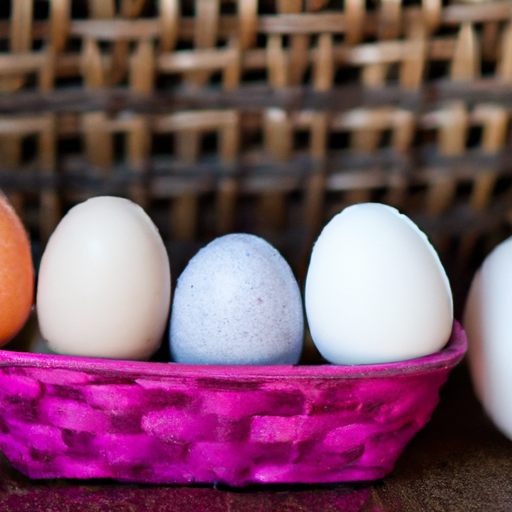Have you ever wondered why some eggs come in different sizes and colors? It turns out that different breeds of chickens have varying capabilities when it comes to egg production and quality. Some breeds are known for laying a high number of eggs per year, while others excel in producing eggs of exceptional quality. In this article, we will explore the fascinating world of chicken breeds and their distinct characteristics when it comes to egg production and quality. Get ready to discover the secrets behind the eggs you enjoy every day!
Physical Characteristics of Chicken Breeds
Size and Weight
Chicken breeds come in a wide range of sizes and weights. Some breeds, such as the Jersey Giant and Brahma, are known for their impressive size and can reach weights of up to 13 pounds. On the other hand, smaller breeds like the Silkie and Serama are much more compact, typically weighing less than 2 pounds. When choosing a breed, it’s important to consider the size and weight that will work best for your needs and the available space you have.
Color and Shape of Eggs
One fascinating aspect of different chicken breeds is the diverse range of egg colors and shapes they produce. While most people are familiar with white and brown eggs, there are many other interesting options. Breeds like the Americauna and Easter Egger lay eggs in shades of blue, green, or even pink. Marans are known for their dark brown eggs, and Welsummers produce eggs with a distinct speckled appearance. In terms of shape, you can find eggs that range from the traditional oval shape to more elongated or pear-shaped varieties.
Egg Production
Factors Affecting Egg Production
Several factors can impact a chicken’s egg production. One crucial factor is age, as hens typically have their peak laying period between 6 and 20 months of age. The quality and consistency of their diet also play a significant role. Chickens require a well-balanced diet that includes the right amount of protein, vitamins, and minerals to maintain optimal egg production. Additionally, factors such as lighting, temperature, and overall health and stress levels can affect a chicken’s egg-laying capabilities.
Breed-Specific Egg Laying Patterns
Different breeds have varying egg-laying patterns. Some breeds, like Leghorns and Sex Links, are highly prolific layers, consistently producing a high number of eggs throughout the year. Conversely, heritage breeds such as Orpingtons and Cochins tend to lay fewer eggs, often taking breaks during the colder months. It’s important to research a breed’s specific egg-laying patterns to align with your production goals and expectations.
Annual Egg Yield
The annual egg yield of a chicken breed refers to the average number of eggs a hen of that breed will lay in a year. Commercial hybrid breeds, known for their high productivity, can yield over 300 eggs per year. However, heritage and rare breeds typically have lower annual egg yields, ranging from 150 to 200 eggs annually. Understanding the annual egg yield of different breeds can help you plan for your egg production needs and requirements.
Egg Quality
Shell Strength and Thickness
The quality of an egg’s shell is an important consideration for both producers and consumers. Some chicken breeds, like the Sussex and Plymouth Rock, are known for laying eggs with strong, thick shells that are less prone to cracking. On the other hand, certain breeds, such as the Polish and Houdan, tend to produce eggs with thinner shells. Shell quality can be influenced by various factors, including genetics, nutrition, and age, so it’s essential to select breeds that meet your specific shell strength requirements.
Egg Size and Weight
Egg size and weight can vary significantly between chicken breeds. Breeds like the Cornish and Cochin tend to lay larger eggs, while bantam breeds produce smaller eggs. In commercial settings, egg size is an important factor as uniformity is desired for packaging and distribution. However, for backyard or small-scale production, a variety of egg sizes may be more acceptable or even preferred, as it adds visual interest and uniqueness to consumers’ egg cartons.
Yolk Color and Consistency
The color and consistency of a chicken’s yolk can vary based on diet and breed. Some breeds, such as the Rhode Island Red and Marans, are known for laying eggs with rich, vibrant yolk colors. This is often attributed to their diet, which includes plenty of leafy greens and insects. Yolk consistency can also differ among breeds, with some hens producing yolks that are firmer or more watery. Yolk color and consistency can play a role in the perceived quality and taste of eggs, making it a desirable characteristic for certain consumers.
Broodiness
Broody Breeds
Broodiness refers to a hen’s tendency to sit on and hatch her eggs. Some chicken breeds, like the Silkies and Orpingtons, are known for their broody tendencies. When a hen goes broody, she may stop laying eggs and become aggressively protective of her nest. This behavior can be an advantage for individuals looking to breed and hatch their chickens, as broody hens are essential for successful incubation. However, broodiness can also be a drawback for those seeking consistent egg production.
Non-Broody Breeds
In contrast to broody breeds, non-broody breeds are less likely to exhibit broodiness. Breeds like Leghorns and Sex Links are known for their non-broody nature and focus more on consistent egg production. Non-broody breeds can be advantageous for commercial operations or individuals seeking a higher egg yield. However, keep in mind that broodiness can vary between individuals within a breed, so it is important to research specific lines or strains within a breed if broodiness is a critical consideration in your selection process.
Effect on Egg Production
Broodiness can significantly affect a hen’s egg production. When a hen goes broody, she stops laying eggs and invests her time and energy into incubating and raising chicks. This break in egg production can last several weeks or even months. For commercial egg production, broodiness is generally undesirable as it disrupts the consistent supply of eggs. However, for those looking to breed their chickens or raise backyard flocks, broodiness can be a valuable trait.
Egg Taste and Flavor
Factors Affecting Taste
Several factors influence the taste and flavor of eggs. Diet plays a crucial role, with chickens that have access to a diverse range of foods often producing more flavorful eggs. For example, chickens allowed to free-range and forage for insects and plants tend to provide eggs with richer flavors. Additionally, the freshness of an egg can impact its taste, as eggs that have been recently laid tend to have a more robust and enjoyable flavor compared to older eggs.
Breed-Specific Flavors
Different chicken breeds can offer unique flavors in their eggs. For example, heritage breeds like the Welsummer and Marans are known for producing eggs with deep, earthy flavors. Breeds like the Leghorn, known for their high egg production, typically produce eggs with a mild and clean taste. Flavor preferences can vary among individuals, so it’s essential to consider breed-specific flavors when selecting chickens for egg production.
Consumer Preferences
Consumer preferences for egg taste and flavor can vary widely. Some individuals prefer eggs with a rich and distinct flavor, while others may prefer milder-tasting options. The growing interest in local and sustainable food sources has led to increased demand for eggs with unique flavors and characteristics. Differentiating and marketing eggs based on breed-specific flavors can be an appealing strategy for small-scale producers and those catering to niche markets.
Climate Adaptability
Cold Hardy Breeds
Certain chicken breeds are better suited to colder climates and can handle lower temperatures. Breeds like the Wyandotte and Australorp have thick and fluffy feathers that provide insulation, helping them withstand cold weather. These breeds often continue to lay eggs even during the winter months when other breeds may slow down or cease egg production. If you live in an area with harsh winters, selecting cold-hardy breeds can help ensure a consistent egg supply year-round.
Heat Tolerant Breeds
In regions with hot climates and high temperatures, it’s important to choose chicken breeds that are heat-tolerant. Breeds like the Leghorn and Mediterranean breeds have lighter feathers and larger combs, which help them dissipate heat more effectively. They are better able to cope with the stress of high temperatures and maintain egg production even during the summer months. Selecting heat-tolerant breeds can be essential for maintaining a reliable egg supply in hotter regions.
Effects on Egg Production
Extreme climates, whether cold or hot, can have an impact on a chicken’s egg-laying capabilities. Cold temperatures can reduce egg production and affect the overall quality of the eggs. In contrast, high temperatures can lead to decreased egg production or even cause hens to stop laying altogether. Selecting chicken breeds that are well-adapted to your specific climate can minimize the negative effects of extreme weather conditions on egg production.
Overall Hardiness and Disease Resistance
Genetic Traits for Hardiness
Certain chicken breeds have genetic traits that contribute to their overall hardiness. Breeds like the Sussex and Rhode Island Red are known for their robust health and ability to withstand various diseases and environmental conditions. These breeds often have strong immune systems and resilient physical characteristics that make them less susceptible to common poultry ailments. When selecting chicken breeds, it’s important to consider their overall hardiness and disease resistance to ensure the long-term health and productivity of your flock.
Breed-Specific Disease Resistance
Different chicken breeds exhibit varying degrees of resistance to specific diseases. For example, some breeds, like the Plymouth Rock and Australorp, are known to have better resistance against respiratory infections. Other breeds, such as the Buckeye and Delaware, may have enhanced resistance against specific external parasites. Understanding breed-specific disease resistance can help you choose the most suitable chicken breeds for your area and reduce the risk of disease outbreaks and associated productivity losses.
Impact on Egg Production
A chicken’s overall hardiness and disease resistance can have a significant impact on its egg production. Healthy chickens are more likely to maintain consistent egg production and have a lower risk of disruptions due to health issues. Breeds with higher disease resistance can better withstand the challenges posed by common poultry diseases, reducing the likelihood of significant drops in egg production. By selecting hardy and disease-resistant breeds, you can help ensure a stable and productive flock.
Commercial Hybrid Breeds
Advantages of Commercial Hybrids
Commercial hybrid chicken breeds have been developed for efficient egg production in commercial settings. These hybrids are carefully bred to maximize factors such as egg yield, egg size, and feed conversion efficiency. They are known for their high productivity and consistent quality, making them popular choices for large-scale egg operations. Commercial hybrids also tend to mature quickly and have good feed-to-egg conversion ratios, making them economically viable options for commercial producers.
Common Hybrid Breeds
Several hybrid breeds dominate the commercial egg production industry. The White Leghorn is a common hybrid known for its exceptional egg-laying capabilities, producing large quantities of white eggs. Other popular hybrid breeds include the ISA Brown, known for its brown egg production, and the Red Sex Link, valued for its high egg production and friendly disposition. These hybrid breeds continue to be favored choices for commercial egg operations due to their reliable performance and desirable egg characteristics.
Egg Production and Quality
Commercial hybrid breeds excel in both egg production and quality. These hybrids are bred specifically for their egg-laying abilities, resulting in high annual egg yields. They also tend to produce eggs of uniform size and weight, meeting the expectations of consumers and making packaging and distribution more efficient. Commercial hybrids are known for their strong shells, making them less prone to cracking and ensuring excellent shell quality. When considering commercial egg production, these hybrid breeds offer reliable performance and consistent egg quality.
Heritage and Rare Breeds
Preservation of Traditional Breeds
Heritage and rare chicken breeds play a vital role in preserving genetic diversity and maintaining traditional breeding lines. These breeds are typically older, traditional breeds that often have historical significance and are recognized for their unique characteristics. By promoting and raising heritage and rare breeds, enthusiasts and breeders help ensure the long-term preservation of genetic material that may be at risk of extinction. Supporting these breeds contributes to biodiversity and helps maintain valuable genetic resources.
Unique Egg Characteristics
One of the attractions of heritage and rare chicken breeds is their ability to produce eggs with distinctive characteristics. These breeds often lay eggs with unique colors, patterns, and sizes that are prized by collectors and individuals interested in specialty eggs. Breeds like the Cream Legbar lay blue eggs, while the Barnevelder produces eggs with deep brown hues. By raising heritage and rare breeds, you can enjoy a diverse range of egg colors and sizes that showcase the rich history and heritage of these breeds.
Challenges for Breeders
Breeding and raising heritage and rare chicken breeds can present challenges for breeders. Due to the smaller populations and increased demand for specific breeds, it can be more difficult to find breeding stock. Maintaining genetic diversity and preventing inbreeding becomes crucial to preserve the breed’s overall health and adaptability. Breeders also need to educate consumers about the unique characteristics and value of heritage and rare breeds, as they may not align with the standardized expectations of size, weight, or egg production seen in commercial hybrids.
Backyard Chicken Breeds
Suitability for Small-Scale Production
Backyard chicken breeds are well-suited for small-scale production and are increasingly popular among urban and suburban residents. These breeds are typically known for their friendly temperaments, ease of care, and adaptability to smaller living spaces. Breeds like the Plymouth Rock and Australorp are often recommended for beginners due to their docile nature and consistent egg production. Backyard chicken breeds provide the opportunity for individuals to produce their own fresh eggs while enjoying the benefits of keeping chickens as pets.
Popular Backyard Chicken Breeds
Several chicken breeds are commonly chosen for backyard flocks. The Rhode Island Red is a popular choice due to its excellent egg production, hardiness, and gentle personality. The Buff Orpington is another favored breed, known for its sweet nature and ability to lay brown eggs consistently. Other popular backyard chicken breeds include the Sussex, Wyandotte, and Easter Egger, which offer a combination of friendly temperaments, good egg production, and aesthetically pleasing appearances.
Egg Production and Quality
Backyard chicken breeds typically offer a balance between egg production and quality. While they may not match the high annual egg yields of commercial hybrids, they make up for it with their consistent egg-laying capabilities. Backyard chicken breeds often lay eggs with excellent shell quality, and their smaller-scale production allows for fresher, more flavorful eggs. These breeds are also celebrated for their colorful egg options, adding visual interest to the egg cartons of small-scale producers and delighting backyard flock enthusiasts.




